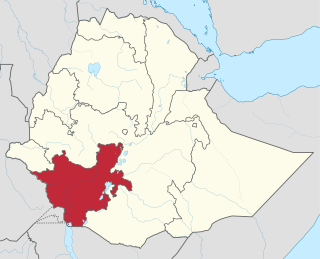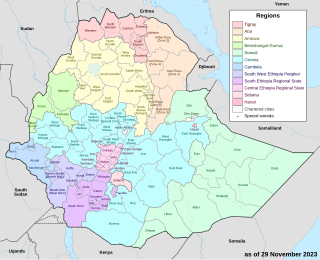Related Research Articles

The Southern Nations, Nationalities, and Peoples' Region was a regional state in southwestern Ethiopia. It was formed from the merger of five kililoch, called Regions 7 to 11, following the regional council elections on 21 June 1992. Its government was based in Hawassa.

Yem Zone is one of the zones in the Central Ethiopia Regional State. Yem is named for the Yem, people whose homeland lies in this zone,. Yem is bordered on the west and north by the Oromia Region, and separated from Gurage on the northeast and Hadiya on the east by the Omo River. High points in Yem include Mount Bor Ama, Mount Azulu and Mount Toba. The administrative center of Yem is Saja.

The Sidama Region is a regional state in southern Ethiopia. It was formed on 18 June 2020 from the Southern Nations, Nationalities, and Peoples' Region (SNNPR) and transformation of the Sidama Zone after a 98.52% vote in favour of increased autonomy in the 2019 Sidama referendum. It is the second smallest regional state in the country, after Harari. Sidama is the name of both the Sidama people and Sidama territory. Sidama is bordered to the south by the Oromia Region (except for a short stretch in the middle where it shares a border with Gedeo zone, in South Ethiopia Regional State, on the west by the Bilate River, which separates it from Wolayita Zone, and on the north and east by the Oromia Region. Towns in Sidama include Hawassa, the capital of Sidama and of SNNPR when it existed, Yirgalem, Wondogenet, Chuko, Hula, Bona, Bursa, Bensa, and Aleta Wendo. Sidama has a population of around 3.2 million in 2017 who speak the Cushitic language Sidama.

South Omo Zone is a zone in the Ethiopian South Ethiopia Regional State. South Omo is bordered to the south by Kenya, to the west by West Omo Zone, to the northwest by Keffa Zone, to the north by Ari Zone and Gofa Zone, to the northeast by Gardula, Ale Zone and Konso and to the east by the Oromia Region. The administrative center of South Omo is Dimeka.

Gurage is a zone in the Central Ethiopia Regional State of Ethiopia. The region is home to the Gurage people. Gurage is bordered on the southeast by Hadiya and Yem Zone, on the northwest by Kebena Special Woreda, north and east by the Oromia Region, and on the southeast by Silt'e. Its highest point is Mount Gurage. Welkite is the administrative centre of the Region; Butajira is the largest city in this zone and the former administrative centre.

Amaro Zone (Kore) is a zone in South west Ethiopia Regional State of Ethiopia. The people are called Kore and their language is Korigna. Amaro kore people are the descendants of the Christian missioners of north Ethiopian sematic peoples of Gonder, who were moved gradually through northern shewa (menze) to central and south western Ethiopian lands of Damot (wolayta), Dawuro, Gamo Gofa and surrounding areas of the region With their Christian traditions and heritages around eleventh; twelfth and thirteenth century. As the native of kore nation theologian Jebdu kassahun evidentially assured and narrated, That was a time of ST. Abune Gebremenfes kidus, st.tekle Haymanot, and emperor Yikuno Amlak, who were preached and expanded Christianity to central and south western Ethiopian lands. Amaro is one of the areas in which members of Kore nations widely live in. Amaro Kore people got zonal status in August 2023 A.D upon the formation of the South west Ethiopia Regional State. In 2011 A.D, the Segen Area Peoples Zone was established, which includes Amaro woreda and the three former special woredas surrounding it. Located in the Great Rift Valley, Amaro kore peoples land is bordered on the south by Burji Zone, on the southwest by Konso Zone, on the west by Dirashe Zone, on the northwest by Gamo Zone and Lake Chamo, and on the north by Lake Abaya and in east and northeast by Oromia Region. It is divided into 35 kebeles. The administrative center of the woreda is Kelle. Jijola woreda, Derba Menena woreda, and Kereda are other growing municipals of the zone.

Konso is a zone in the South Ethiopia Regional State, Ethiopia. It was formerly a woreda. Prior to 2011, Konso was not part of any Zone in the Southern Nations, Nationalities and Peoples' Region (SNNPR) and was therefore considered a special woreda, an administrative subdivision which is similar to an autonomous area. In 2011, the Segen Area Peoples Zone was established, which includes Konso special woreda and the 3 former woredas surrounding it. This special woreda is named after the Konso people. Located in the Great Rift Valley, Konso is bordered on the south by the Oromia Region, on the west by the South Omo Zone, on the northwest by Alle special woreda, on the north by Dirashe special woreda, on the northeast by Amaro special woreda, and on the east by Burji special woreda. The Sagan River, which flows south then west to join the Weito, defines part of the woreda's boundary with Burji and the entire length of the boundary with the Oromia Region. The administrative center is Karati; other towns in Konso include Fasha and Sagen. After protesting by residents to become a zone for several years, Konso became a zone in November 2018.
Kuraz is one of the woredas in the Southern Nations, Nationalities, and Peoples' Region of Ethiopia. It is the homeland of Daasanach people. Part of the Debub Omo Zone, Kuraz is bordered on the south by Kenya, on the west by the Ilemi Triangle, on the north by Nyangatom, and on the east by Hamer. The Omo River is flowing through Kuraz to Lake Turkana at the border of Kenya. The administrative center of this woreda is Omorate. Nyangatom woreda was separated from Kuraz.
Menjiwo is a district in the South West Region of Ethiopia. The name Menjiwo is derived from the province Manjo of the Kingdom of Kaffa; however, the province of Manjo lay within the boundaries of neighboring Ginbo, while Menjiwo occupies the lands of the Gallo province of the former kingdom. Part of the Keffa Zone, Menjiwo is bordered on the south by Telo, on the southwest by Decha, on the west by Ginbo, on the north by the Gojeb River which separates it from the Oromia Region, and on the east by the Konta special district. The major town in Menjiwo is Adiya Kaka.
Kochere is one of the woredas in the Southern Nations, Nationalities, and Peoples' Region of Ethiopia. Part of the Gedeo Zone, Kochere is bordered on the east by Gedeb, on the southwest by the Oromia Region, and on the north by Yirgachefe. Towns in Kochere include Fisehagenet and Chelelektu. Gedeb woreda was separated from Kochere.

Basketo Zone is a zone in the South Ethiopia Regional State of Ethiopia, named after its inhabitants, the Basketo people. It was formerly a part of the Southern Nations, Nationalities and Peoples' Region (SNNPR)'s, and because Basketo was not part of any administrative Zone in the SNNPR, it was considered a special woreda—an administrative subdivision which is similar to an autonomous area.
Chencha is a woreda in Southern Nations, Nationalities, and Peoples' Region, Ethiopia. Part of the Gamo Zone, Chencha is bordered on the south by Arba Minch Zuria, on the west by Dita & Gofa on the north by Kucha and Boreda, and on the east by Mirab Abaya. Towns in Chencha include Chencha, Dorze, Dokko and Ezo.
Bonke is one of the woredas in the Southern Nations, Nationalities, and Peoples' Region of Ethiopia. Part of the Gamo Gofa Zone, Bonke is bordered on the south by the Dirashe special woreda, on the west by the Weito River which separates it from Kemba, on the northwest by Deramalo, on the north by Dita, and on the east by Arba Minch Zuria. The major town in Bonke is Gerese.
Selamago is a woreda in the Southern Nations, Nationalities, and Peoples' Region of Ethiopia. Part of the Debub Omo Zone, Selamago is bordered on the south by Nyangatom, on the west and north by the Omo River which separates it from the Bench Maji, Keffa and Konta, on the northeast by the Gamo Gofa, on the east by the Basketo and Bako Gazer, and on the southeast by the Usno River which separates it from Bena Tsemay; the Mago River defines part of the boundary with Bako Gazer. The administrative center of Selamago is Hana.
Omo Nada is one of the woredas in the Oromia region of Ethiopia. Part of the Jimma Zone, Omo Nada is bordered on the south by the Gojeb River, which separates it from the Southern Nations, Nationalities and Peoples Region (SNNPR), on the west by Dedo, on the northwest by Kersa, on the north by Nadhi Gibe, on the northeast by Sokoru, and on the east by the Omo River which separates it from the SNNPR. Nada is the administrative center of the district; other towns in Omo Nada include Asendabo.
Abaya is a woreda in the Oromia Region, Ethiopia. It is part of former Gelana Abaya woreda what was divided for Abaya and Gelana woredas. Part of the Borena Zone, Gelana Abaya was bordered on the south by Hagere Mariam, and on the west, north and east by the Southern Nations, Nationalities, and Peoples Region (SNNPR). Lake Abaya, on the western border, is divided between this woreda and the SNNPR. However, the Guji Oromo who live in Nechisar National Park are claimed to be administratively part of this woreda, in a kebele called "Irgansaa".
The Yem are an ethnic group living in south-western Ethiopia. Their native language is Yemsa, one of the Omotic languages, although many also speak Amharic. The neighbors of the Yem include the Gurage, Hadya, and Kembata to the east across the Omo River and the Jimma Oromo to the south, north and west.
The Basketo people are an Omotic-speaking ethnic group whose homeland lies in the southern part of the Southern Nations, Nationalities, and Peoples Region (SNNPR) of Ethiopia. The Basketo special woreda is named after this ethnic group. According to the 2007 Ethiopian national census, this ethnic group has 78,284 members, of whom 99.3% live in the SNNPR.
The Opuo language, or Tʼapo, is a Koman language spoken by the Opo people of Ethiopia and South Sudan. It has a lexical similarity of 24% with Komo. The language is also called Opo-Shita, Opo, Opuo, Cita, Ciita, Shita, Shiita, Ansita, Kina, and Kwina. The self-name for the language is Tʼapo. "Langa" is a derogatory term for its speakers used by the Anuak.
Dimma is a woreda in Gambela Region, Ethiopia. Part of the Anuak Zone, Dimma is bordered on the southeast by the Southern Nations, Nationalities and Peoples Region (SNNPR), on the southwest by the Akobo River which separates it from South Sudan, on the north by Gog, and on the northeast by the Mezhenger Zone. The major town in Dimma is Dimma.
References
- ↑ "Census 2007", first draft, Table 5.
- ↑ "The 1994 Population and Housing Census of Ethiopia" Archived 2008-12-07 at the Wayback Machine (accessed 31 January 2009)
- 1 2 González-Ruibal, Alfredo (2014). An Archaeology of Resistance: Materiality and Time in an African Borderland. Rowman & Littlefield. pp. 77–78. ISBN 978-1-4422-3091-0.